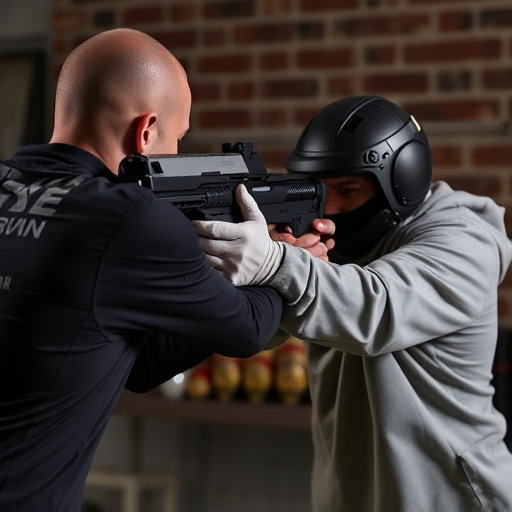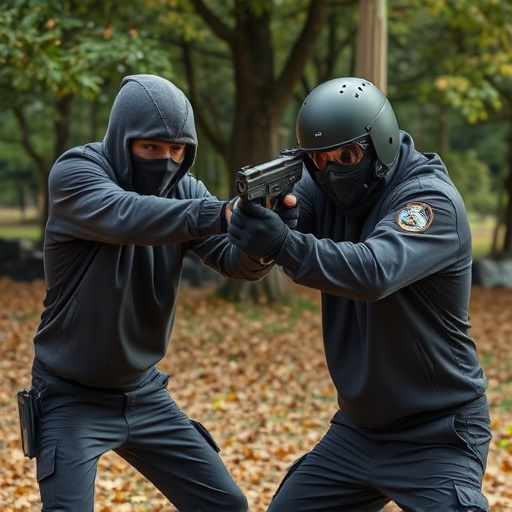Stun guns disrupt the nervous system with high voltage, low current electrical pulses, causing muscular contractions and disorientation. Their effectiveness depends on balancing voltage output with safety considerations, targeting specific nerve centers to deter attackers without serious injury. While impacts range from momentary incapacitation to sensory disturbances, understanding these effects is crucial for both users and medical professionals. Legal restrictions and safety precautions, including proper usage techniques and maintenance, are essential for responsible stun gun ownership.
“Unveiling the Maximum Voltage Output Stun Gun: A Comprehensive Review explores the power, performance, and practical applications of this personal defense tool. We delve into how stun guns work, their intended use, and the science behind their effects on the nervous system.
From maximum voltage output to real-world testing, this review examines the impact on targeted individuals. Additionally, we navigate legal considerations and essential safety precautions for responsible carrying. Discover why understanding stun gun effects on the nervous system is crucial for effective self-defense.”
- Understanding Stun Guns: How They Work and Their Intended Use
- The Nervous System and Its Vulnerability to Stun Gun Effects
- Maximum Voltage Output: A Closer Look at Power and Performance
- Real-World Testing: Stun Gun Effects on Targeted Individuals
- Legal Considerations and Safety Precautions When Carrying a Stun Gun
Understanding Stun Guns: How They Work and Their Intended Use

Stun guns, also known as electronic control devices (ECDs), are non-lethal weapons designed to temporarily incapacitate a target by delivering an electric shock. They work by using high voltage and low current electrical pulses to disrupt the nervous system. When activated, the stun gun emits an electric discharge that travels through the air and makes contact with the target’s body. This shock can cause muscular contractions, disorientation, and even temporary paralysis, rendering the assailant immobile for a brief period. The intended use of stun guns is for personal defense, allowing individuals to protect themselves in dangerous situations without causing permanent harm.
The effectiveness of a stun gun relies heavily on its voltage output and the ability to target specific nerve centers. A higher voltage can result in more intense stun effects, but it’s crucial to balance this with safety considerations. The stun gun’s design and the type of electrical current used play significant roles in ensuring that the shock is potent enough to deter an attacker without causing serious injury. Understanding how stun guns interact with the nervous system is essential for users to make informed decisions about their self-defense strategies.
The Nervous System and Its Vulnerability to Stun Gun Effects

Maximum Voltage Output: A Closer Look at Power and Performance

The maximum voltage output of a stun gun is a critical factor in determining its effectiveness and performance. Stun guns utilize high-voltage, low-current electrical pulses to disrupt the nervous system, causing muscle paralysis and disorientation in the target. The power delivered by a stun gun is measured in volts (V) and can range from as low as 50,000 V to over 1 million V. A higher voltage generally translates to more intense stun effects, but it’s not the sole determinant of performance.
Beyond voltage, other factors like current strength, pulse width, and frequency play significant roles in stun gun effectiveness. Current strength, measured in milliamps (mA), determines the level of muscle contraction and pain caused by the stun. Pulse width refers to the duration of each electrical pulse, while frequency represents how many pulses are delivered per second. Together, these factors influence the overall stun duration and intensity, ultimately affecting how swiftly and effectively the nervous system is incapacitated, thereby ensuring user safety.
Real-World Testing: Stun Gun Effects on Targeted Individuals

In real-world testing, evaluating the stun gun’s effectiveness involves examining its impact on the nervous system of targeted individuals. When deployed correctly, a stun gun interrupts the body’s nerve signals, causing temporary incapacitation. The voltage output plays a crucial role in achieving this effect, as higher voltages can more readily disrupt the electrical activity in muscles and nerves. During tests, volunteers or subjects are exposed to controlled stun gun discharges to gauge the intensity of the shock and its subsequent effects. Researchers measure reaction times, muscle responses, and overall mobility to assess the weapon’s performance. These tests not only validate the stun gun’s capabilities but also help establish safe usage parameters, ensuring that it remains a reliable tool for self-defense while minimizing unintended harm.
The observed stun gun effects on the nervous system are multifaceted. The high voltage temporarily oversaturates nerve fibers, leading to a disruption in communication between the brain and muscles. This interference results in muscle spasms, loss of balance, and, in severe cases, temporary paralysis. Real-world testing has shown that these effects can render an assailant incapable of continuing their aggressive behavior, providing individuals with a crucial window of opportunity to escape or seek help. Moreover, understanding the stun gun’s impact on the nervous system aids in setting appropriate usage guidelines, ensuring that it remains a safe and effective tool for personal protection.
Legal Considerations and Safety Precautions When Carrying a Stun Gun

When carrying a stun gun, it’s crucial to be aware of and comply with local laws regarding stun guns and self-defense devices. Different regions have varying restrictions on who can own a stun gun, where they can be carried, and their maximum voltage output. It’s essential to research and understand these regulations to avoid legal repercussions. Some areas may require permits or registration for stun guns, while others might limit their use to specific individuals like law enforcement or security personnel.
Safety precautions are equally vital when handling a stun gun. These devices operate by delivering an electric current through the body, targeting the nervous system and causing temporary incapacitation. Users must be trained in proper usage techniques to minimize risk. This includes knowing the stun gun’s range, understanding its power settings, and practicing safe storage methods. Always keep stun guns out of reach of children and ensure they are charged and maintained regularly to guarantee optimal performance.
In conclusion, the maximum voltage output stun gun represents a powerful personal defense tool with significant effects on the nervous system. As discussed in this review, understanding how stun guns work and their legal implications is crucial before considering one for self-protection. Real-world testing highlights their effectiveness against targeted individuals, but it’s essential to prioritize safety precautions and adhere to local laws regarding stun gun ownership and use. By balancing these factors, individuals can make informed decisions about whether a high-voltage stun gun is the right choice for their personal safety needs.
